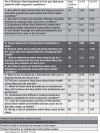The development and testing of a measure assessing clinician beliefs about patient self-management
- PMID: 19906211
- PMCID: PMC5060511
- DOI: 10.1111/j.1369-7625.2009.00571.x
The development and testing of a measure assessing clinician beliefs about patient self-management
Abstract
Background: Clinicians have been slow to embrace support for patient self-management.
Objective: To explore clinicians' beliefs about patient self-management and specifically assess which patient competencies clinicians believe are most important for their patients.
Methods: Using items adapted from the Patient Activation Measure (PAM) as a basis, a new measure that assesses clinicians' beliefs about patient self-management was created using Rasch analysis. The development and testing of the new measure Clinician Support for Patient Activation Measure (CS-PAM) is described here. Primary care clinicians from the UK and the USA were recruited to participate in the survey (n = 175).
Findings: The CS-PAM reliably measures clinician attitudes about the patient role in the care process. Clinicians strongly endorse that patients should follow medical advice but are less likely to endorse that patients should be able to make independent judgements or take independent actions. Endorsed to a lesser degree was the idea that patients should be able to function as a member of the care team. Least endorsed was the notion that patients should be independent information seekers.
Discussion: Clinicians' views appear to be out of step with current policy directions and professional codes. Clinicians need support to transition to understand the need to support patients as independent actors.
Figures
References
-
- World Health Organization . 10 Facts About Chronic Disease. Available at: http://www.who.int, accessed on 08 April, 2009.
-
- UK Department of Health . Raising the Profile of Long Term Conditions Care. A Compendium of Information. London: UK Department of Health, January 2008.
-
- World Health Organization . Innovative Care for Chronic Conditions. Building Blocks for Action. Geneva: World Health Organisation, 2002.
-
- Wagner EH, Austin BT, Davis C, Hindmarsh M, Schaefer J, Bonomi A. Improving chronic illness care: translating evidence into action. Health Affairs (Millwood), 2001; 20: 64–78. - PubMed
-
- Lorig K. Self‐management of chronic illness: a model for the future. Generations, 1993; XVII: 11–14.
Publication types
MeSH terms
LinkOut - more resources
Full Text Sources
Miscellaneous



